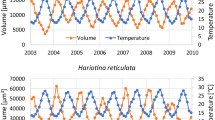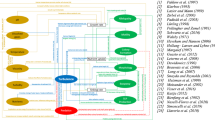Abstract
Paradoxically, although turbulence characterises the open water environments of planktonic organisms in lakes, rivers and seas, most species of phytoplankton are smaller than the size of the smallest eddies dissipating the energy and, so, must function in an immediate medium which is inherently viscous. Intensively mixed systems, such as wind-stirred shallow lakes, rivers and estuaries, however, constantly readjust the vertical position of suspended algae and, often, other non-living, light-absorbing particles with the effect that the light field to which the algae are subject is erratic and the received day-time light dose is aggregately depressed: cells need to photoadapt accordingly. In fluvial environments the additional constraint of rapid, horizontal, supposedly unidirectional, transport is applied, requiring the attribute of rapid processing of primary products and cell replication. Significant downstream recruitment, however, is benefitted by the presence of so-called ‘dead-zones’ which retain water (and suspended plankton) sufficiently to accommodate additional cell divisions.
Similar content being viewed by others
References
Anagnostidis, K. & J. Komárek, 1988. Modern approach to the classification of cyanophytes. 3-Oscillatoriales. Arch. Hydrobiol. (Suppl.) 80: 327–427.
Bailey-Watts, A.E., A. Kirika, L. May & D.H. Jones, 1990. Changes in phytoplankton over various time scales in a shallow, eutrophic loch: the Loch Leven experience with special reference to the influence of flushing rate. Freshwat. Biol. 23: 85–111.
Berger, C., 1984. Consistent blooming of Oscillatoria agardhii Gom. in shallow hypertrophic lakes. Verh. int. Ver. Limnol. 22: 910–916.
Berger, C., 1989. In situ primary production, biomass and light regime in the Wolderwijd, the most stable Oscillatoria agardhii lake in the Netherlands. Hydrobiologia 185: 233–244.
Butcher, R.W., 1924. The plankton of the River Wharfe. Naturalist, Hull, April–June, 175–214.
Canelli, E. & G.W. Fuhs, 1976. Effects of the sinking rate of two diatoms (Thalassiosira spp.) on uptake from low concentrations of phosphate. J. Phycol. 12: 93–99.
Carling, P.A., 1992a. In-stream hydraulics and sediment transport. In P. Calow & G.E. Petts (eds), The rivers handbook. Volume 1. Blackwell Scientific Publications, Oxford: 101–125.
Carling, P.A., 1992b. The nature of the fluid boundary layer and the selection of parameters for benthic ecology. Freshwat. Biol. 28: 273–282.
Denman, K.L. & A.E. Gargett, 1983. Time and space scales of vertical mixing and advection of phytoplankton in the upper ocean. Limnol. Oceanogr. 28: 801–815.
Descy, J.-P., 1987. Phytoplankton composition and dynamics in the River Meuse (Belgium). Arch. Hydrobiol. (Suppl.) 78: 225–245.
Falkowski, P.G., 1980. Light-shade adaptation in marine phytoplankton. In P.G. Falkowski, Primary productivity in the sea. Plenum, New York: 99–119.
Falkowski, P.G., 1984. Physiological responses of phytoplankton to natural light regimes. J. Plankton Res. 6: 295–307.
Fritsch, F.E., 1902. Algological notes III. Preliminary report on the phytoplankton of the Thames. Ann. Bot. 16: 1–9.
Gavis, J., 1976. Munk and Riley revisited: nutrient diffusion transport and rates of phytoplankton growth. J. mar. Res. 34: 161–179.
Gibson, C.E., 1984. Sinking rates of planktonic diatoms in an unstratified lake: a comparison of field and laboratory observations. Freshwat. Biol. 14: 631–638.
Gibson, C.E., R.B. Wood, E.L. Dickson & D.M. Jewson, 1971. The succession of phytoplankton in Lough Neagh, 1968–1970. Mitt. int. Ver. Limnol. 19: 146–160.
Greenberg, A.E., 1964. Plankton of the Sacramento River. Ecology 45: 40–49.
Harris, G.P. (1978) Photosynthesis, productivity and growth: the physiological ecology of phytoplankton. Ergebnisse der Limnologie 10: 1–171.
Hecky, R.E. & H.J. Kling, 1981. The phytoplankton and protozooplankton of the euphotic zone of Lake Tanganyika: species composition, biomass, chlorophyll content and spatio-temporal distribution. Limnol. Oceanogr. 26: 548–564.
Holmes, N.T.H. & B.A. Whitton, 1981. Phytoplankton of four rivers, the Tyne, Wear, Tees and Swale. Hydrobiologia 80: 111–127.
Jones, R.I. & R.J. Barrington, 1985. A study of the suspended algae in the River Derwent, Derbyshire, UK. Hydrobiologia 128: 255–264.
Kofoid, C.A., 1903. The plankton of the Illinois River and its basin. Part I. Quantitative investigations and general results. Bull. Illinois State Laboratory Nat. Hist. 6: 95–629.
Köhler, J., 1993. Growth, production and losses of phytoplankton in the lowland River Spree. I. Population dynamics. J. Plankton Res. 15: 335–349.
Kolmogorov, A.N., 1941. The local structure of turbulence in incompressible viscous fluid for very large Reynolds numbers. Dokl. Akad. Nauk SSSR 30: 299–303.
Lack, T.J., 1971. Quantitative studies on the phytoplankton of the rivers Thames and Kennet at Reading. Freshwat. Biol. 1: 213–224.
Levich, V.G., 1962. Physicochemical hydrodynamics. Prentice Hall, Englewood Cliffs, 700 pp.
Liepolt, R., 1961. Limnologische Forschungen im Osterreichen Donaustrom. Verh. int. Ver. Limnol. 14: 422–429.
Liere, L. van & L. Mur, 1979. Growth kinetics of Oscillatoria agardhii Gomont in continuous culture, limited in its growth by the light energy supply. J. gen. Microbiol. 115: 153–160.
Lund, J.W.G., 1962. The periodicity of Melosira islandica O. Müll in Great Slave Lake. J. Fish. Res. Bd Can. 19: 501–504.
Mann, K.H. & J.R.N. Lazier, 1991. Dynamics of marine ecosystems: biological — physical interactions in the ocean. Blackwell Scientific Publications, Boston, 466 pp.
Margalef, R., 1960. Ideas for a synthetic approach to the ecology of running waters. Int. Revue ges. Hydrobiol. 45: 133–153.
Milliman, J.D., 1990. Fluvial sediments in coastal seas: flux and fate. Nature & Resources 26 (4): 12–22.
Moss, B. & H. Balls, 1989. Phytoplankton distribution in a floodplain lake and river system. II. Seasonal changes in the phytoplankton communities and their control by hydrology and nutrient availability. J. Plankton Res. 11: 836–867.
Munawar, M. & I.F. Munawar, 1982. Phycological studies in Lakes Ontario, Erie, Huron and Superior. Can. J. Bot. 60: 1837–1858.
Munk, W.H. & G.A. Riley, 1952. Absorption of nutrients by aquatic plants. J. mar. Res. 11: 215–240.
Neale, P.J., 1987. Algal photoinhibition and photosynthesis in the aquatic environment. In E. Kyle, C.J. Arntzen & B. Osmond (eds), Photoinhibition. Elsevier, Amsterdam: 39–65.
Neale, P.J., S.I. Heaney & G.H.M. Jaworski, 1991. Responses to high irradiance contribute to the decline of the spring diatom maximum. Limnol. Oceanogr. 36: 761–768.
Oakey, N.S. & J.A. Elliot, 1982. Dissipation within the surface mixed layer. J. phys. Oceanogr. 12: 171–185.
Pasciak, W.I. & J. Gavis, 1974. Transport limitation of nutrient uptake in phytoplankton. Limnol. Oceanogr. 19: 881–888.
Reynolds, C.S., 1983. A physiological interpretation of the dynamics responses of populations of a planktonic diatom to physical variability of the environment. New Phytol. 95: 41–53.
Reynolds, C.S., 1984a. The ecology of freshwater phytoplankton. Cambridge University Press, Cambridge, 384 pp.
Reynolds, C.S., 1984b. Phytoplankton periodicity: the interaction of form, function and environmental variability. Freshwat. Biol. 14: 111–142.
Reynolds, C.S., 1988. Functional morphology and the adaptive strategies of freshwater phytoplankton. In C.D. Sandgren (ed), Growth and reproductive strategies of freshwater phytoplankton. Cambridge University Press, New York: 388–433.
Reynolds, C.S., 1989. Physical determinants of phytoplankton succession. In U. Sommer (ed.), Plankton ecology. Springer Verlag, New York: 9–56.
Reynolds, C.S., 1992a. Dynamics, selection and composition of phytoplankton in relation to vertical structure in lakes. Ergebn. Limnol. 35: 13–31.
Reynolds, C.S., 1992b. Algae. In P. Calow, & G.E. Petts (eds), The rivers handbook. Volume I. Blackwell Scientific Publications, Oxford: 195–217.
Reynolds, C.S., 1993a. Swings and roundabouts: engineering the environment of algal growth. In K.N. White, E.G. Bellinger, A.J. Saul, M. Symes & K. Hendry (eds), Urban waterside regeneration: problems and prospects. Ellis Horwood, Chichester: 330–349.
Reynolds, C.S., 1993b. Scales of disturbance and their role in plankton ecology. Hydrobiologia 249: 157–171.
Reynolds, C.S. 1994a. The role of fluid motion in the dynamics of phytoplankton in lakes and rivers. In: P.S. Giller, A.G. Hilldrew & D. Raffaelli (eds), Ecology of aquatic organisms: scale, pattern, process. Blackwell Scientific Publications, Oxford: 141–187.
Reynolds, C.S., 1994b. Paradigms regained — potamoplankters do it on the side. In A.J.D. Ferguson & D. Harper (eds), The ecological basis for river management. Wiley-Interscience, London.
Reynolds, C.S., P.A. Carling & K.J. Beven, 1991. Flow in river channels: new insights into hydraulic retention. Arch. Hydrobiol. 121: 171–179.
Reynolds, C.S. & M.S. Glaister, 1993. Spatial and temporal changes in phytoplankton abundance in the upper and middle reaches of the River Severn. Large Rivers 1.
Reynolds, C.S., M.L. White, R.T. Clarke & A.F.H. Marker, 1990. Suspension and settlement of particles in flowing water: comparison of the effects of varying water depth and velocity in circulating channels. Freshwat. Biol. 24: 23–34.
Reynolds, C.S. & S.W. Wiseman, 1982. Sinking losses of phytoplankton in closed limnetic systems. J. Plankton Res. 4: 489–522.
Reynolds, C.S., H. Morison & C. Butterwick, 1982. The sedimentary flux of phytoplankton in the south basin of Windermere. Limnol. Oceanogr. 27: 1162–1175.
Rossolimo, L.L., 1957. Temperature regime of Lake Baikal (In Russian). Trudy Baikal'skoi limnologicheskoi Stantsii 16: 1–551.
Sabater, S. & I. Muñoz, 1990. Successional dynamics of the phytoplankton in the lower part of the River Ebro. J. Plankton Res. 12: 573–592.
Skabichevskii, A.P., 1960. Planktonic diatom algae of freshwater of the USSR: systematics, ecology and distribution (In Russian). Izdatel'stvo, Moskovsogo Universiteta, Moskva, 351 pp.
Smith, I.R., 1992. Hydroclimate: the influence of water movement on freshwater ecology. Elsevier, London, 304 pp.
Spigel, R.H. & J. Imberger, 1987. Mixing processes relevant to phytoplankton dynamics in lakes. New Zealand J. mar. freshwat. Res. 21: 361–377.
Swale, E.M.F., 1969. Phytoplankton in two English rivers. J. Ecol. 57: 1–23.
Talling, J.F., 1966. The annual cycle of stratification and phytoplankton growth in Lake Victoria (East Africa). Int. Revue ges. Hydrobiol. 51: 545–621.
Tandeau de Marsac, N.T., 1977. Occurrence and nature of chromatic adaptations in cyanobacteria. J. Bact. 130: 82–91.
Tennekes, H. & J.L. Lumley, 1972. A first course in turbulence. M.I.T. Press, Cambridge (Mass.), 300 pp.
Welch, P.S., 1952. Limnology (2nd Edition). McGraw-Hill, New York, 538 pp.
Wawrik, F., 1962. Zur Frage: Führt der Donaustrom autochtones Plankton? Arch. Hydrobiol. (Suppl.) 27: 28–35.
Whitton, B.A., 1966. Algae in St James Park Lake. London Naturalist 45: 26–28.
Williams, L.G., 1972. Plankton diatom species biomass and the quality of American rivers and the Great Lakes. Ecology 53: 1038–1050.
Young, P.C. & S.G. Wallis, 1987. The aggregated dead-zone model for dispersion. In BHRA, Proceedings of the conference on water-quality modelling in the inland natural environment. BHRA, Cranfield: 421–433.
Zacharias, O., 1898. Das Potamoplankton. Zool. Anz. 21: 41–48.
Author information
Authors and Affiliations
Rights and permissions
About this article
Cite this article
Reynolds, C.S. The long, the short and the stalled: on the attributes of phytoplankton selected by physical mixing in lakes and rivers. Hydrobiologia 289, 9–21 (1994). https://doi.org/10.1007/BF00007405
Issue Date:
DOI: https://doi.org/10.1007/BF00007405




